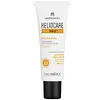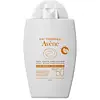What's inside
What's inside
 Key Ingredients
Key Ingredients

 Benefits
Benefits

 Concerns
Concerns

 Ingredients Side-by-side
Ingredients Side-by-side

Water
Skin ConditioningC12-15 Alkyl Benzoate
AntimicrobialArginine
MaskingPhenylbenzimidazole Sulfonic Acid
UV AbsorberDisodium Phenyl Dibenzimidazole Tetrasulfonate
UV AbsorberBis-Ethylhexyloxyphenol Methoxyphenyl Triazine
Skin ConditioningTitanium Dioxide
Cosmetic ColorantHexylene Glycol
EmulsifyingC14-22 Alcohols
Emulsion StabilisingC12-20 Alkyl Glucoside
EmulsifyingDiethylamino Hydroxybenzoyl Hexyl Benzoate
UV FilterNylon-12
Myristyl Alcohol
EmollientDipropylene Glycol Dibenzoate
EmollientDiethylhexyl Butamido Triazone
UV AbsorberPhenoxyethanol
PreservativePolypodium Leucotomos Leaf Extract
Skin ProtectingEthylhexyl Ferulate
AntioxidantFerulic Acid
AntimicrobialCaffeic Acid
AntioxidantPhysalis Angulata Extract
Skin ProtectingCeteareth-25
CleansingCaprylyl Glycol
EmollientMelanin
Skin ProtectingMyristyl Glucoside
CleansingEthylhexyl Triazone
UV AbsorberCaprylyl Methicone
Skin ConditioningHydrolyzed Wheat Protein/Pvp Crosspolymer
Glycerin
Humectant3-O-Ethyl Ascorbic Acid
Skin ConditioningAlumina
AbrasivePPG-15 Stearyl Ether Benzoate
EmollientDisodium Ethylene Dicocamide PEG-15 Disulfate
CleansingCamellia Sinensis Extract
AntioxidantEthylhexylglycerin
Skin ConditioningTocopheryl Acetate
AntioxidantXanthan Gum
EmulsifyingPhytosphingosine Hcl
Skin ConditioningArabidopsis Thaliana Extract
AntioxidantEthyl Lauroyl Arginate Hcl
Skin ConditioningPanthenyl Triacetate
Parfum
MaskingSimethicone
EmollientOxothiazolidine
Skin ProtectingDisodium EDTA
Silica
AbrasiveEthyl Linoleate
EmollientCaprylic/Capric Triglyceride
MaskingOleyl Alcohol
EmollientButylene Glycol
HumectantLecithin
EmollientSodium Benzoate
MaskingTocopherol
AntioxidantLinalool
PerfumingLimonene
PerfumingWater, C12-15 Alkyl Benzoate, Arginine, Phenylbenzimidazole Sulfonic Acid, Disodium Phenyl Dibenzimidazole Tetrasulfonate, Bis-Ethylhexyloxyphenol Methoxyphenyl Triazine, Titanium Dioxide, Hexylene Glycol, C14-22 Alcohols, C12-20 Alkyl Glucoside, Diethylamino Hydroxybenzoyl Hexyl Benzoate, Nylon-12, Myristyl Alcohol, Dipropylene Glycol Dibenzoate, Diethylhexyl Butamido Triazone, Phenoxyethanol, Polypodium Leucotomos Leaf Extract, Ethylhexyl Ferulate, Ferulic Acid, Caffeic Acid, Physalis Angulata Extract, Ceteareth-25, Caprylyl Glycol, Melanin, Myristyl Glucoside, Ethylhexyl Triazone, Caprylyl Methicone, Hydrolyzed Wheat Protein/Pvp Crosspolymer, Glycerin, 3-O-Ethyl Ascorbic Acid, Alumina, PPG-15 Stearyl Ether Benzoate, Disodium Ethylene Dicocamide PEG-15 Disulfate, Camellia Sinensis Extract, Ethylhexylglycerin, Tocopheryl Acetate, Xanthan Gum, Phytosphingosine Hcl, Arabidopsis Thaliana Extract, Ethyl Lauroyl Arginate Hcl, Panthenyl Triacetate, Parfum, Simethicone, Oxothiazolidine, Disodium EDTA, Silica, Ethyl Linoleate, Caprylic/Capric Triglyceride, Oleyl Alcohol, Butylene Glycol, Lecithin, Sodium Benzoate, Tocopherol, Linalool, Limonene
Titanium Dioxide 11.4%
Cosmetic ColorantZinc Oxide 14.6%
Cosmetic ColorantWater
Skin ConditioningCoco-Caprylate/Caprate
EmollientIsocetyl Stearoyl Stearate
EmollientIsopropyl Palmitate
EmollientIsodecyl Neopentanoate
EmollientIsododecane
EmollientIsohexadecane
EmollientPtfe
Triethylhexanoin
MaskingDicaprylyl Ether
EmollientPEG-30 Dipolyhydroxystearate
EmulsifyingAlumina
AbrasiveStearic Acid
CleansingCaprylyl Glycol
EmollientPEG-45/Dodecyl Glycol Copolymer
Emulsion StabilisingSilica
AbrasiveBenzoic Acid
MaskingCaprylic/Capric Triglyceride
MaskingDisodium EDTA
Disteardimonium Hectorite
StabilisingHectorite
AbsorbentGlyceryl Behenate
EmollientGlyceryl Dibehenate
EmollientHelianthus Annuus Seed Oil
EmollientPentaerythrityl Tetra-Di-T-Butyl Hydroxyhydrocinnamate
AntioxidantPolyamide-3
Sodium Chloride
MaskingTocopheryl Acetate
AntioxidantTocopheryl Glucoside
EmollientTribehenin
EmollientTriethoxycaprylylsilane
Titanium Dioxide 11.4%, Zinc Oxide 14.6%, Water, Coco-Caprylate/Caprate, Isocetyl Stearoyl Stearate, Isopropyl Palmitate, Isodecyl Neopentanoate, Isododecane, Isohexadecane, Ptfe, Triethylhexanoin, Dicaprylyl Ether, PEG-30 Dipolyhydroxystearate, Alumina, Stearic Acid, Caprylyl Glycol, PEG-45/Dodecyl Glycol Copolymer, Silica, Benzoic Acid, Caprylic/Capric Triglyceride, Disodium EDTA, Disteardimonium Hectorite, Hectorite, Glyceryl Behenate, Glyceryl Dibehenate, Helianthus Annuus Seed Oil, Pentaerythrityl Tetra-Di-T-Butyl Hydroxyhydrocinnamate, Polyamide-3, Sodium Chloride, Tocopheryl Acetate, Tocopheryl Glucoside, Tribehenin, Triethoxycaprylylsilane
 Reviews
Reviews

Ingredients Explained
These ingredients are found in both products.
Ingredients higher up in an ingredient list are typically present in a larger amount.
Alumina is another name for the compound aluminum oxide. It is used as a thickener, absorbent, and abrasive.
As an absorbent, alumina can give a mattifying effect. It is used in mineral sunscreens to help coat nano-sized filters, such as titanium dioxide. By increasing the size of the UV filters, these ingredients stay on the skin for a longer time. By coating small sized ingredients, alumina helps thicken a product.
Alumina may be used as an abrasive, or exfoliant.
Alumina is naturally occurring in the mineral corundum. Certain varieties of corundum create rubies and sapphires. Corundum is also the crystalline form of alumina.
Learn more about AluminaThis ingredient is an emollient, solvent, and texture enhancer. It is considered a skin-softener by helping the skin prevent moisture loss.
It helps thicken a product's formula and makes it easier to spread by dissolving clumping compounds.
Caprylic Triglyceride is made by combining glycerin with coconut oil, forming a clear liquid.
While there is an assumption Caprylic Triglyceride can clog pores due to it being derived from coconut oil, there is no research supporting this.
Learn more about Caprylic/Capric TriglycerideCaprylyl Glycol is a humectant and emollient, meaning it attracts and preserves moisture.
It is a common ingredient in many products, especially those designed to hydrate skin. The primary benefits are retaining moisture, skin softening, and promoting a healthy skin barrier.
Though Caprylyl Glycol is an alcohol derived from fatty acids, it is not the kind that can dry out skin.
This ingredient is also used as a preservative to extend the life of products. It has slight antimicrobial properties.
Learn more about Caprylyl GlycolDisodium EDTA plays a role in making products more stable by aiding other preservatives.
It is a chelating agent, meaning it neutralizes metal ions that may be found in a product.
Disodium EDTA is a salt of edetic acid and is found to be safe in cosmetic ingredients.
Learn more about Disodium EDTASilica, also known as silicon dioxide, is a naturally occurring mineral. It is used as a fine, spherical, and porous powder in cosmetics.
Though it has exfoliant properties, the function of silica varies depending on the product.
The unique structure of silica enhances the spreadability and adds smoothness, making it a great texture enhancer.
It is also used as an active carrier, emulsifier, and mattifier due to its ability to absorb excess oil.
In some products, tiny microneedles called spicules are made from silica or hydrolyzed sponge. When you rub them in, they lightly polish away dead skin layers and enhance the penetration of active ingredients.
Learn more about SilicaTitanium dioxide is a mineral UV filter widely used in sunscreens and cosmetics.
It is one of only two UV filters officially classified as “mineral” by regulatory agencies, the other being zinc oxide.
Titanium dioxide provides broad-spectrum protection mostly in the UVB and UVAII range, with some protection in the UVAI range.
While its UVA protection isn’t as strong as zinc oxide’s, the difference is minor.
A common myth is that mineral UV filters reflect UV light. However, modern research shows titanium dioxide absorbs UV radiation like chemical filters (~95% absorption & 5% reflection).
Thanks to its non-irritating nature, titanium dioxide is suitable for sensitive, acne-prone, or redness-prone skin. It is unlikely to cause "eye sting" like other sunscreen ingredients.
A major drawback of this ingredient is its white cast and thick texture. This is why mineral sunscreens often leave a white cast and are less cosmetically elegant than chemical/hybrid sunscreens.
To improve white cast and spreadability, micronized or nano-sized titanium dioxide is often used.
There are ongoing concerns surrounding nano-titanium oxide's impact on marine ecosystems.
There is no conclusive evidence that any form of titanium oxide (or any other sunscreen ingredients) will cause harm to marine ecosystems or coral reefs. The science is still developing but many consumers are keeping a close eye on this issue.
Please note, many destinations have reef-safety sunscreen rules. For instance, the U.S. Virgin Islands advises all visitors to use non-nano mineral sunscreens.
Nano mineral sunscreens once raised safety concerns about absorption into skin.
Extensive research has shown that they do not penetrate healthy or damaged skin; they remain safely on the surface and the top layer of dead skin (stratum corneum).
You'll likely find titanium dioxide bundled with alumina, silica, or dimethicone. These ingredients help make titanium dioxide highly photostable; this prevents it from interacting with other formula components under UV light.
Learn more about Titanium DioxideTocopheryl Acetate is AKA Vitamin E. It is an antioxidant and protects your skin from free radicals. Free radicals damage the skin by breaking down collagen.
One study found using Tocopheryl Acetate with Vitamin C decreased the number of sunburned cells.
Tocopheryl Acetate is commonly found in both skincare and dietary supplements.
Learn more about Tocopheryl AcetateWater. It's the most common cosmetic ingredient of all. You'll usually see it at the top of ingredient lists, meaning that it makes up the largest part of the product.
So why is it so popular? Water most often acts as a solvent - this means that it helps dissolve other ingredients into the formulation.
You'll also recognize water as that liquid we all need to stay alive. If you see this, drink a glass of water. Stay hydrated!
Learn more about Water